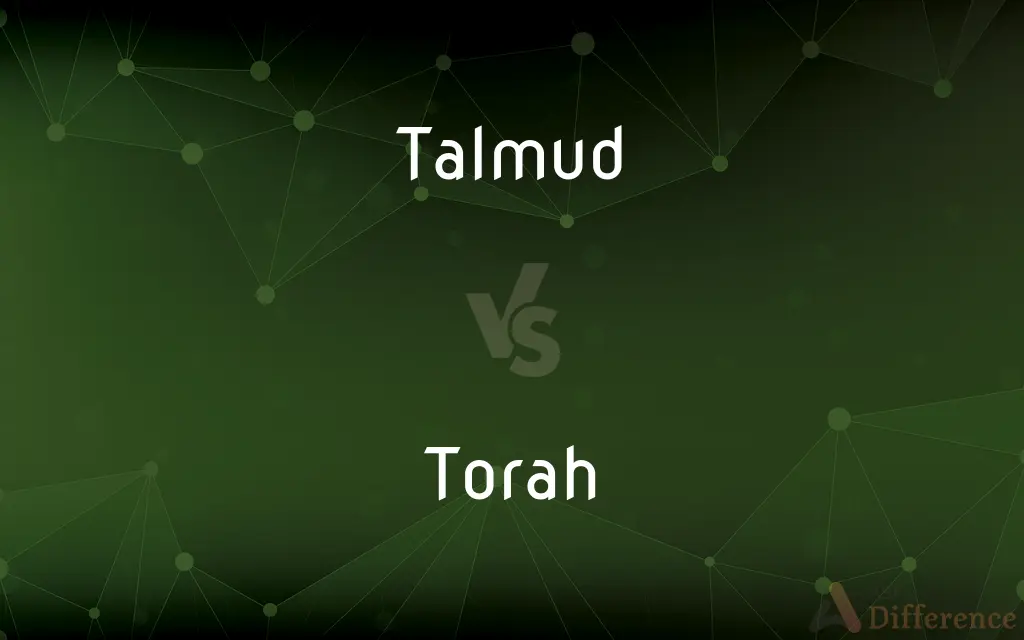Talmud vs. Torah — What's the Difference?
By Tayyaba Rehman — Updated on October 27, 2023
Talmud is rabbinic discussions on Jewish law, ethics, and customs; Torah is the central reference of Jewish religious law and theology.

Difference Between Talmud and Torah
Table of Contents
ADVERTISEMENT
Key Differences
The Talmud and Torah are both central texts in the Jewish tradition. The Torah, often referred to as the Five Books of Moses, is the foundational text of Judaism. It contains the stories of the Jewish people, laws, and teachings, spanning from the creation of the world to the death of Moses. The Talmud, on the other hand, is a collection of rabbinic discussions and interpretations of the Torah.
While the Torah is viewed as the word of God given directly to Moses on Mount Sinai, the Talmud is a compilation of oral teachings passed down through generations. These teachings delve deeper into the intricacies of the laws and stories found in the Torah, providing context, details, and insights. The Talmud and Torah together form the basis for Jewish law, customs, and theology.
The structure and composition of the two texts differ significantly. The Torah is divided into five books: Genesis, Exodus, Leviticus, Numbers, and Deuteronomy. Each book contains narratives, laws, and commandments. The Talmud, however, is made up of two main components: the Mishnah, which is a written compilation of oral traditions, and the Gemara, which is a detailed commentary on the Mishnah.
In Jewish life and practice, both the Talmud and Torah hold immense importance. While the Torah serves as the foundational scripture and is read in synagogues during worship services, the Talmud offers guidance on how to apply the Torah's teachings to daily life and interpret its sometimes ambiguous passages. Together, the Talmud and Torah provide a comprehensive understanding of Jewish faith, law, and tradition.
Comparison Chart
Nature
Rabbinic discussions
Direct word of God
ADVERTISEMENT
Composition
Mishnah + Gemara
Five Books (Genesis to Deuteronomy)
Purpose
Interpretation of Torah
Foundational religious text
Origins
Oral traditions compiled
Given to Moses on Mount Sinai
Content
Commentary, laws, ethics
Narratives, laws, commandments
Compare with Definitions
Talmud
A text containing the Mishnah and the Gemara.
The Talmud's structure facilitates detailed discussions on the Torah's commandments.
Torah
A text encompassing laws, narratives, and commandments.
The Torah provides the basic framework for Jewish beliefs and practices.
Talmud
A collection of rabbinic discussions interpreting the Torah.
Scholars often refer to the Talmud for deeper insights into the Torah.
Torah
The Five Books of Moses, foundational to Judaism.
The Torah narrates the journey of the Israelites from Egypt to the Promised Land.
Talmud
The written record of the Oral Torah.
The Talmud expands upon the teachings found in the Torah.
Torah
The central reference of Jewish religious law and theology.
The Torah is read aloud in synagogues during weekly services.
Talmud
A central text of Rabbinic Judaism.
The Talmud offers a comprehensive guide to Jewish life and law.
Torah
A scripture believed to be the word of God given to Moses.
The Torah's teachings influence all facets of Jewish life.
Talmud
An intricate compilation of laws, ethics, and customs.
By studying the Talmud, one can understand the nuances of Jewish law.
Torah
Torah (; Hebrew: תּוֹרָה, "Instruction", "Teaching" or "Law") has a range of meanings. It can most specifically mean the first five books (Pentateuch or Five Books of Moses) of the Hebrew Bible, namely (in their commonly used names) Genesis, Exodus, Leviticus, Numbers and Deuteronomy.
Talmud
The Talmud (; Hebrew: תַּלְמוּד Tálmūḏ) is the central text of Rabbinic Judaism and the primary source of Jewish religious law (halakha) and Jewish theology. Until the advent of modernity, in nearly all Jewish communities, the Talmud was the centerpiece of Jewish cultural life and was foundational to "all Jewish thought and aspirations", serving also as "the guide for the daily life" of Jews.The term "Talmud" normally refers to the collection of writings named specifically the Babylonian Talmud (Talmud Bavli), although there is also an earlier collection known as the Jerusalem Talmud (Talmud Yerushalmi).
Torah
The first five books of the Hebrew Scriptures. See Table at Bible.
Talmud
The collection of ancient Rabbinic writings consisting of the Mishnah and the Gemara, constituting the basis of religious authority in Orthodox Judaism.
Torah
A scroll of parchment containing the first five books of the Hebrew Scriptures, used in a synagogue during services.
Talmud
The body of the Jewish civil and canonical law not comprised in the Pentateuch.
Torah
The entire body of religious law and learning including both sacred literature and oral tradition.
Talmud
The collection of ancient rabbinic writings on Jewish law and tradition (the Mishna and the Gemara) that constitute the basis of religious authority in Orthodox Judaism
Torah
A law; a precept.
A considerable body of priestly Toroth.
Torah
Divine instruction; revelation.
Tora, . . . before the time of Malachi, is generally used of the revelations of God's will made through the prophets.
Torah
The Pentateuch or "Law of Moses."
The Hebrew Bible is divided into three parts: (1) The Torah, "Law," or Pentateuch. (2) The Prophets (Nevi'im in Hebrew) . . . (3) The Kethubim, or the "Writings," generally termed Hagiographa. From the first letters of these three parts, the word "Tanakh" is derived, and used by Jews as the name of their Bible, the Christian Old Testament.
Torah
The whole body of the Jewish sacred writings and tradition including the oral tradition
Torah
The first of three divisions of the Hebrew Scriptures comprising the first five books of the Hebrew Bible considered as a unit
Torah
(Judaism) the scroll of parchment on which the first five books of the Hebrew Scripture is written; is used in a synagogue during services
Torah
The primary document from which Jewish tradition stems.
By following the Torah, Jewish individuals connect with their ancestral faith.
Common Curiosities
Is the Torah considered the word of God?
Yes, the Torah is believed to be the direct word of God given to Moses on Mount Sinai.
Why is the Talmud important in Judaism?
The Talmud offers guidance on interpreting and applying the Torah's teachings to daily life.
How do Jews use the Torah in worship?
The Torah is read aloud during worship services in synagogues.
How does the Talmud relate to the Torah?
The Talmud provides detailed discussions, interpretations, and applications of the teachings found in the Torah.
Is the Talmud considered divine like the Torah?
While the Torah is viewed as the direct word of God, the Talmud is seen as human interpretations and discussions of the Torah.
How is the Torah structured?
The Torah is divided into five books: Genesis, Exodus, Leviticus, Numbers, and Deuteronomy.
Are there different versions of the Torah?
The content of the Torah is consistent, but there can be variations in translation and commentary across Jewish traditions.
What is the Talmud?
The Talmud is a collection of rabbinic discussions and interpretations of the Torah.
What is the Torah?
The Torah is the central reference of Jewish religious law and theology, often referred to as the Five Books of Moses.
Can the Torah be translated into other languages?
Yes, the Torah has been translated into many languages, though Hebrew is considered its sacred language.
Do all Jewish denominations study the Talmud?
While the Talmud is central in many Jewish traditions, the extent and manner of its study can vary among denominations.
Is the Talmud only about laws?
While the Talmud contains extensive discussions on laws, it also delves into ethics, customs, and stories.
Is the Torah the same as the Old Testament in Christianity?
The Torah forms the first five books of the Old Testament, but the Old Testament contains other books beyond the Torah.
What are the main components of the Talmud?
The Talmud consists of the Mishnah, a written compilation of oral traditions, and the Gemara, a commentary on the Mishnah.
How old is the Talmud?
The Talmud was developed over several centuries, with its final form emerging around the 5th century CE.
Share Your Discovery

Previous Comparison
Evaporation vs. Distillation
Next Comparison
Capacitor vs. SupercapacitorAuthor Spotlight
Written by
Tayyaba RehmanTayyaba Rehman is a distinguished writer, currently serving as a primary contributor to askdifference.com. As a researcher in semantics and etymology, Tayyaba's passion for the complexity of languages and their distinctions has found a perfect home on the platform. Tayyaba delves into the intricacies of language, distinguishing between commonly confused words and phrases, thereby providing clarity for readers worldwide.














































